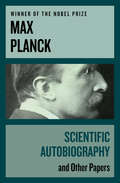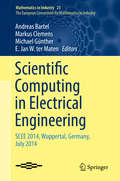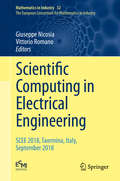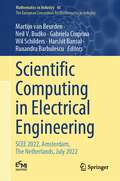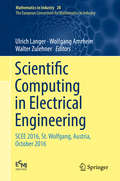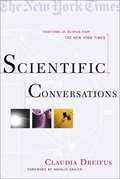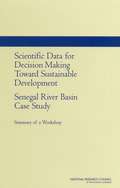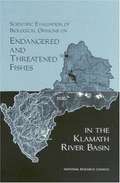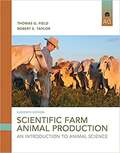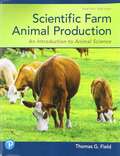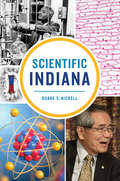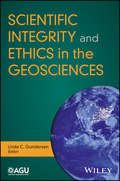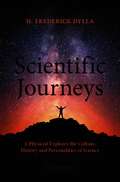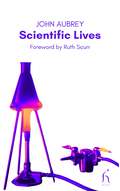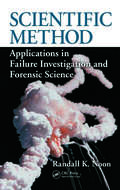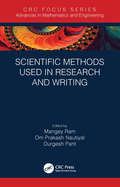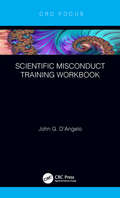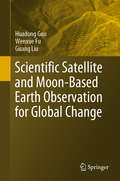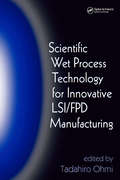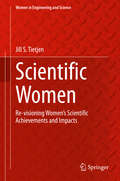- Table View
- List View
Scientific Autobiography: And Other Papers
by Max PlanckIn this fascinating autobiography from one of the foremost geniuses of twentieth-century physics, Max Planck tells the story of his life, his aims, and his thinking. Published posthumously, the papers in this volume were written for the general reader and make accessible Planck&’s scientific theories as well as his philosophical ideals, including his thoughts on ethics and morals.
Scientific Ballooning: Technology and Applications of Exploration Balloons Floating in the Stratosphere and the Atmospheres of Other Planets
by Naoki Izutsu Toyoo Abe Nobuyuki Yajima Takeshi ImamuraThe aim of this book is to introduce scientific ballooning to the many people who are interested in the use of balloons for scientific applications. The book offers a basic understanding of the engineering details and the scientific research giving rise to balloon activities going on today. Above all, the book will serve as a guidebook for young scientists and researchers seeking to become involved in space science and technology by participating in balloon projects. The book deals with three types of balloons: large stratospheric balloons used for scientific purposes, rubber balloons used for aerological observations, and planetary balloons to be used in the atmospheres of other planets. The book provides many figures and photographs, and offers a systematic description of balloon technologies and related matters from historical background to current research topics. The contents include a theoretical discussion of ballon shape design, analysis and synthesis of flight dynamics, actual launching procedure, flight operations, and typical applications of ballooning in various scientific fields. Detailed meteorological descriptions, especially of the Earth's stratosphere and the atmosphere of other planets, are provided for investigating actual flight behavior.
Scientific Communication Across the Iron Curtain
by Christopher D. HollingsThis monograph provides a concise introduction to the tangled issues of communication between Russian and Western scientists during the Cold War. It details the extent to which mid-twentieth-century researchers and practitioners were able to communicate with their counterparts on the opposite side of the Iron Curtain. Drawing upon evidence from a range of disciplines, a decade-by-decade account is first given of the varying levels of contact that existed via private correspondence and conference attendance. Next, the book examines the exchange of publications and the availability of one side's work in the libraries of the other. It then goes on to compare general language abilities on opposite sides of the Iron Curtain, with comments on efforts in the West to learn Russian and the systematic translation of Russian work. In the end, author Christopher Hollings argues that physical accessibility was generally good in both directions, but that Western scientists were afflicted by greater linguistic difficulties than their Soviet counterparts whose major problems were bureaucratic in nature. This volume will be of interest to historians of Cold War science, particularly those who study communications and language issues. In addition, it will be an ideal starting pointing for anyone looking to know more about this fascinating area.
Scientific Computing in Electrical Engineering
by Andreas Bartel Michael Günther E. Jan W. ter Maten Markus ClemensThis book is a collection of selected papers presented at the 10thInternational Conference on Scientific Computing in Electrical Engineering(SCEE), held in Wuppertal, Germany in 2014. The book is divided into fiveparts, reflecting the main directions of SCEE 2014: 1. Device Modeling,Electric Circuits and Simulation, 2. Computational Electromagnetics, 3. CoupledProblems, 4. Model Order Reduction, and 5. UncertaintyQuantification. Each part starts with a general introduction followed bythe actual papers. The aim of the SCEE 2014 conference was to bring together scientistsfrom academia and industry, mathematicians, electrical engineers, computerscientists, and physicists, with the goal of fostering intensive discussions onindustrially relevant mathematical problems, with an emphasis on the modelingand numerical simulation of electronic circuits and devices, electromagneticfields, and coupled problems. The methodological focus was on model orderreduction and uncertainty quantification.
Scientific Computing in Electrical Engineering: SCEE 2018, Taormina, Italy, September 2018 (Mathematics in Industry #32)
by Giuseppe Nicosia Vittorio RomanoThis collection of selected papers presented at the 12th International Conference on Scientific Computing in Electrical Engineering, SCEE 2018, held in Taormina, Sicily, Italy, in September 2018, showcases the state of the art in SCEE.The aim of the SCEE 2018 conference was to bring together scientists from academia and industry, mathematicians, electrical engineers, computer scientists, and physicists, and to promote intensive discussions on industrially relevant mathematical problems, with an emphasis on the modeling and numerical simulation of electronic circuits and of electromagnetic fields. This extensive reference work is divided into five parts: Computational Electromagnetics, Device Modeling and Simulation, Circuit Simulation, Mathematical and Computational Methods, Model Order Reduction. Each part starts with a general introduction, followed by the respective contributions. The book will appeal to mathematicians and electrical engineers. Further, it introduces algorithm and program developers to recent advances in the other fields, while industry experts will be introduced to new programming tools and mathematical methods.
Scientific Computing in Electrical Engineering: SCEE 2022, Amsterdam, The Netherlands, July 2022 (Mathematics in Industry #43)
by Martijn Van Beurden Wil Schilders Neil V. Budko Gabriela Ciuprina Harshit Bansal Ruxandra BarbulescuThis volume comprises selected papers presented at the 14th International Conference on Scientific Computing in Electrical Engineering, SCEE 2022, held in Amsterdam, The Netherlands, in July 2022. The aim of the SCEE 2022 conference was to bring together scientists – mathematicians, electrical engineers, computer scientists, and physicists, from universities and industry – to have in-depth discussions of the latest scientific results in Computational Science and Engineering relevant to Electrical Engineering and to stimulate and inspire active participation of young researchers.This extensive reference work is divided into four parts: Part I Circuit Simulation and Design.- Part II Device Simulation.- Part III Computational Electromagnetics.- Part IV Mathematical and Computational Methods. Each part starts with a general introduction, followed by the respective contributions. The book will appeal to mathematicians and electricalengineers. Further, it introduces algorithm and program developers to recent advances in the other fields, while industry experts will be introduced to new programming tools and mathematical methods.
Scientific Computing in Electrical Engineering: Scee 2016, St. Wolfgang, Austria, October 2016 (Mathematics In Industry Ser. #28)
by Ulrich Langer Wolfgang Amrhein Walter ZulehnerThis collection of selected papers presented at the 11th International Conference on Scientific Computing in Electrical Engineering (SCEE), held in St. Wolfgang, Austria, in 2016, showcases the state of the art in SCEE. The aim of the SCEE 2016 conference was to bring together scientists from academia and industry, mathematicians, electrical engineers, computer scientists, and physicists, and to promote intensive discussions on industrially relevant mathematical problems, with an emphasis on the modeling and numerical simulation of electronic circuits and devices, electromagnetic fields, and coupled problems. The focus in methodology was on model order reduction and uncertainty quantification. This extensive reference work is divided into six parts: Computational Electromagnetics, Circuit and Device Modeling and Simulation, Coupled Problems and Multi‐Scale Approaches in Space and Time, Mathematical and Computational Methods Including Uncertainty Quantification, Model Order Reduction, and Industrial Applications. Each part starts with a general introduction, followed by the respective contributions. This book will appeal to mathematicians and electrical engineers. Further, it introduces algorithm and program developers to recent advances in the other fields, while industry experts will be introduced to new programming tools and mathematical methods.
Scientific Conversations: Interviews on Science from the New York Times
by Claudia DreifusDr. Benjamin Carson, a pediatric neurosurgeon, describes what it feels like to dig around in someone's brain. Dr. Leon Lederman, Nobel laureate, displays the wry humor that has earned him the title :the Mel Brooks of the physics world. : Pulitzer Prize-winning author John McPhee reveals how he cam to terms with the vastness of geological time and that he once tied himself to a chair in order to write. Ira Flatow, host of National Public Radio's Science Friday, recalls how his childhood fascination with electrical outlets almost caused him to blow up his mother's bathroom. Astronomer Royal Sir Martin Rees discloses his astrological sign. In these thirty-eight interviews, originally published in the weekly Science Times section of The New York Times, Claudia Dreifus brings all of her colorful personality to bear on her subjects, as well as an arsenal of philosophy, literature, current events, and an unmistakable curiosity. As each conversation unfolds, we learn surprising and fascinating things about some of the most intriguing figures and issues in science today. Dreifus's outsider status in the world of science is perhaps one of her greatest interviewing strengths. A political journalist for much of her career, she stumbled into a position at the Science Times. With little more scientific background that the average person, she scrambled to prepare for her meetings with some of the greatest minds across a broad range of disciplines-from astronomy to geology, from biology and medicine to computer science and mathematics. She soon found herself in a refreshingly candid environment, so unlike the one she had known on the political beat. It is from this perspective that she makes science tangible, accessible, and entertaining. When you add a deep-rooted scientific curiosity to the savvy of a crack political reporter, you get more than just extraordinary chemistry: Claudia Dreifus reminds us that interviewing can be an art form.
Scientific Data for Decision Making Toward Sustainable Development: Senegal River Basin Case Study
by U.S. National Committee for CODATAScientific databases relating to the environment, natural resources, and public health on the African continent are, for various reasons, difficult to create and manage effectively. Yet the creation of these and other types of databases--and their subsequent use to produce new information and knowledge for decision-makers--is essential to advancing scientific and technical progress in that region and to its sustainable development. The U.S. National Committee for CODATA collaborated with the Senegalese National CODATA Committee to convene a "Workshop on Scientific Data for Decision-Making Toward Sustainable Development: Senegal River Basin Case Study," which was held on 11-15 March 2002, in Dakar, Senegal. The workshop examined multidisciplinary data sources and data handling in the West Africa region, using the Senegal River Basin as a case study, to determine how these data are or can be better used in decision making related to sustainable development.
Scientific Evaluation Of Biological Opinions On Endangered And Threatened Fishes In The Klamath River Basin: Interim Report
by Committee on Endangered Threatened Fishes in the Klamath River BasinA report on Scientific Evaluation Of Biological Opinions On Endangered And Threatened Fishes In The Klamath River Basin
Scientific Farm Animal Production: An Introduction
by Robert Taylor Thomas FieldWith Scientific Farm Animal Production, students of animal agriculture get a comprehensive, science-based approach to building livestock and poultry management systems for food, fiber, and recreation. It effectively integrates the scientific disciplines that support livestock and poultry production with detailed information about the primary livestock species, appropriate management protocols, and the market forces that impact demand across the supply chain. As a result of a comprehensive review by nearly 20 professionals, this new edition features increased clarity, depth and accuracy, including improved end-of-chapter questions; updated and enhanced figures and color photos; the latest demographic data; an expanded discussion of social and consumer issues; and an authoritative look at the trends, issues, and opportunities for animal agriculture.
Scientific Farm Animal Production: An Introduction To Animal Science
by Robert Taylor Thomas FieldScientific Farm Animal Production: An Introduction to Animal Scienceis the single best integrated resource combining a strong disciplinary focus with best practices in production for the major livestock and poultry industries. A detailed study of eight primary livestock industries is examined along with market forces affecting demand across the supply chain as well as related societal issues and challenges. The 12th edition has updated industry data and insights, improved graphics and images, and simplified material adding greater meaning for students without a livestock production background.
Scientific Foundations of Engineering
by Mcknight Stephen W. Christos ZahopoulosProviding an overview of the foundations of engineering from a fundamental scientific and physical perspective, this book reinforces the basic scientific and mathematical principles which underpin a range of engineering disciplines and applications. It covers the basics of physics, including quantum physics, as well as some key topics in chemistry, making it a valuable resource for both students and professionals looking to gain a more coherent and interdisciplinary understanding of engineering systems. Throughout, the focus is on common features of physical systems (such as mechanical and electronic resonance), showing how the same underlying principles apply to different disciplines. Problems are provided at the end of each chapter including conceptual questions and examples to demonstrate the practical application of fundamental scientific principles. These include real-world examples, which are solvable using computational packages such as MATLAB.
Scientific Indiana
by Duane S. NickellScientists who lived, worked or were educated in the Hoosier State have made fundamental contributions to astronomy, biology, chemistry and physics. Astronomer Vesto Slipher discovered that almost all other galaxies were moving away from our own Milky Way Galaxy. Biologist Alfred Kinsey was a pioneer in the field of human sexuality. Chemist Harold Urey discovered deuterium and worked on the Manhattan Project. And physicist Edward Purcell discovered nuclear magnetic resonance, the basis for MRI, one of the most significant medical advances in a century. Scientists with Indiana connections have also been awarded a dozen Nobel Prizes. Hoosier science teacher Duane S. Nickell offers a glimpse into the lives of seventeen scientific heroes from Indiana.
Scientific Integrity and Ethics in the Geosciences
by Linda C. GundersenScience is built on trust. The assumption is that scientists will conduct their work with integrity, honesty, and a strict adherence to scientific protocols. Written by geoscientists for geoscientists, Scientific Integrity and Ethics in the Geosciences acquaints readers with the fundamental principles of scientific ethics and shows how they apply to everyday work in the classroom, laboratory, and field. Resources are provided throughout to help discuss and implement principles of scientific integrity and ethics. Volume highlights include: Examples of international and national codes and policies Exploration of the role of professional societies in scientific integrity and ethics References to scientific integrity and ethics in publications and research data Discussion of science integrity, ethics, and geoethics in education Extensive coverage of data applications Scientific Integrity and Ethics in the Geosciences is a valuable resource for students, faculty, instructors, and scientists in the geosciences and beyond. It is also useful for geoscientists working in industry, government, and policymaking.
Scientific Journeys: A Physicist Explores the Culture, History and Personalities of Science
by H. Frederick DyllaThis collection of essays traces a scientific journey bookmarked by remarkable mentors and milestones of science. It provides fascinating reading for everyone interested in the history, public appreciation, and value of science, as well as giving first-hand accounts of many key events and prominent figures. The author was one of the “sputnik kids” growing up in the US at the start of the space age. He built a working laser just two years after they were first invented, an experience that convinced him to become a physicist. During his 50-year career in physics, many personalities and notable events in science and technology helped to form his view of how science contributes to the modern world, including his conviction that the impact of science can be most effective when introduced within the context of the humanities - especially history, literature and the arts.From the Foreword by former U.S. Congressman, Rush D. Holt: In this volume, we have the wide-ranging thoughts and observations of Fred Dylla, an accomplished physicist with an engineer’s fascination for gadgets, a historian’s long perspective, an artist’s aesthetic eye, and a teacher’s passion for sharing ideas. Throughout his varied career [...] his curiosity has been his foremost characteristic and his ability to see the connection between apparently disparate things his greatest skill. [...] Here he examines the roots and growth of innovation in examples from Bell Laboratories, Edison Electric Light Company, and cubist painter Georges Braque. He considers the essential place of publishing in science, that epochal intellectual technique for learning how the world works. He shows the human enrichment and practical benefits that derive from wise investments in scientific research, as well as the waste resulting from a failure to embrace appropriate technologies.
Scientific Knowledge Communication in Museums (Research For Development Ser.)
by Edoardo Rovida Alberto RovettaThis book explains the general principles of scientific and technical communication in the context of modern museums. It also examines, with the aid of informative case studies, the different means by which knowledge can be transmitted, including posters, objects, explanatory guidance, documentation, and catalogues. Highlighting the ever more important role of multimedia and virtual reality components in communicating understanding of and facilitating interaction with the displayed object, it explores how network communications systems and algorithms can be applied to offer individual users the information that is most pertinent to them. The book is supported by a Dynamic Museums app connected to museum databases where series of objects can be viewed via cloud computing and the Internet and printed using 3D printing technology. This book is of interest to a diverse readership, including all those who are responsible for museums’ collections, operations, and communications as well as those delivering or participating in courses on museums and their use, communication design and related topics.
Scientific Lives (Hesperus Classics)
by John Aubrey"The honourable Robert Boyle esq., the son of Richard Boyle, the first Earl of Cork, was born at Lismore in the county of Cork. He was nursed by an Irish nurse, after the Irish manner, where they put the child in a pendulous satchel instead of a cradle, with a slit for the child's head to peep out." This new selection from John Aubrey's enormous work of 17th-century biography, Brief Lives, brings together his writings on contemporary scientists, explorers and men of innovation, including astronomer Edmund Halley, celebrated mapmaker Wenceslaus Hollar, and the architects Christopher Wren and Inigo Jones. Simultaneously quirky, amusing, and informative, these pieces together provide a fascinating portrait of an exciting and inventive age.
Scientific Method: Applications in Failure Investigation and Forensic Science (International Forensic Science and Investigation)
by Randall K. NoonMost failure or accident investigations begin at the end of the story: after the explosion, after the fire has been extinguished, or after the collapse. In many instances, information about the last event and the starting event is known reasonably well. Information about what occurred between these endpoints, however, is often unclear, confusing, and perhaps contradictory. Scientific Method: Applications in Failure Investigation and Forensic Science explains how scientific investigative methods can best be used to determine why and how a particular event occurred.While employing examples from forensic engineering, the book uses principles and ideas applicable to most of the forensic sciences. The author examines the role of the failure investigator, describes the fundamental method for investigation, discusses the optimal way to organize evidence, and explores the four most common reasons why some investigations fail. The book provides three case studies that exemplify proper report writing, contains a special chapter profiling a criminal case by noted forensic specialist Jon J. Nordby, and offers a reading list of resources for further study.Concise and illustrative, this volume demonstrates how the scientific method can be applied to failure investigation in ways that avoid flawed reasoning while delivering convincing reconstruction scenarios. Investigators can pinpoint where things went wrong, providing valuable information that can prevent another catastrophe.
Scientific Methods Used in Research and Writing (Advances in Mathematics and Engineering)
by Mangey Ram Om Prakash Nautiyal Durgesh PantResearch publications, projects, and teaching learning theories have become very important to universities, institutions, organizations, and industries. Many submissions are rejected due to author's lack of writing and research skills. This new book provides a quick, basic starting point to learning the needed skills. The book discusses the statistical methods involved, covers the development of academic writing skills for a higher impact, teaches learning theories, and uses a structured and holistic approach for educational research proposal development. This book will be used by research scholars, undergraduates, postgraduates, and anyone interested in engineering and learning the basic academic writing skills and scientific methods needed.
Scientific Misconduct Training Workbook (Global Science Education)
by John Gaetano D'AngeloThe field of ethics in science aims to improve the way the audience perceives science, and this unique workbook discusses the areas of ethics and scientific misconduct. It provides assessments and exercises for learners to work through in groups or alone. Completion of the workbook but especially the assessment and tests will earn the learner a certificate for scientific misconduct training compiled by the author, and the certificate is available from the author's own website. This volume is a companion to the author's published volume, Ethics in Science: Ethical Misconduct in Scientific Research, Second Edition and will appeal to undergraduates, graduates and even high school students. Features: A unique training workbook in ethics and good conduct, easliy accessible and user friendly Unlike books in this area which mostly cover the theoretical foundations of ethics in science, here the author provides a practical workbook and ancillaries Case studies and a PowerPoint presentation are provided and readers will receive a certificate of completion There is a wealth of instructor resources available from the homepage A knowledge of scientific misconduct is of utmost importance in an era of mass higher education
Scientific Ocean Drilling
by Committee on the Review of the Scientific Accomplishments Assessment of the Potential for Future Transformative Discoveries U.S.-Supported Scientific Ocean DrillingThrough direct exploration of the subseafloor, U. S. -supported scientific ocean drilling programs have significantly contributed to a broad range of scientific accomplishments in Earth science disciplines, shaping understanding of Earth systems and enabling new fields of inquiry. Scientific Ocean Drilling: Accomplishments and Challenges reviews the scientific accomplishments of U. S. -supported scientific ocean drilling over the past four decades. The book evaluates how the programs (Deep Sea Drilling Project [DSDP], 1968-1983, Ocean Drilling Program [ODP], 1984-2003, and Integrated Ocean Drilling Program [IODP], 2003-2013) have shaped understanding of Earth systems and Earth history and assessed the role of scientific ocean drilling in enabling new fields of inquiry. This book also assesses the potential for transformative discoveries for the next proposed phase of scientific ocean drilling, which is scheduled to run from 2013 to 2023. The programs' technological innovations have played a strong role in these accomplishments. The science plan for the proposed 2013-2023 program presents a strong case for the continuation of scientific ocean drilling. Each of the plan's four themes identifies compelling challenges with potential for transformative science that could only be addressed through scientific ocean drilling, although some challenges appear to have greater potential than others. Prioritizing science plan challenges and integrating multiple objectives into single expeditions would help use resources more effectively, while encouraging technological innovations would continue to increase the potential for groundbreaking science.
Scientific Satellite and Moon-Based Earth Observation for Global Change (Springer Remote Sensing/photogrammetry Ser.)
by Huadong Guo Wenxue Fu Guang LiuGlobal change involves complex and far-reaching variations in the Earth’s systems, and satellite observations have been widely used in global change studies. Over the past five decades, Earth observation has developed into a comprehensive system that can conduct dynamic monitoring of the land, the oceans and the atmosphere at the local, regional and even global scale. At the same time, although a large number of Earth observation satellites have been launched, very few of them are used in global change studies. The lack of scientific satellite programs greatly hinders research on global change. This book proposes using a series of global change scientific satellites to establish a scientific observation grid for global environmental change monitoring from space, and offers the first comprehensive review of lunar-based Earth observation. These scientific satellites could provide not only basic datasets but also scientific support in facilitating advances in international global change research.
Scientific Wet Process Technology for Innovative LSI/FPD Manufacturing
by Tadahiro OhmiAs science pushes closer toward the atomic size scale, new challenges arise to slow the pace of the miniaturization that has transformed our society and fueled the information age. New technologies are necessary to surpass these obstacles and realize the tremendous growth predicted by Moore's law. Assembled from the works of pioneering researchers, Scientific Wet Process Technology for Innovative LSI/FPD Manufacturing presents new developments and technologies for producing the next generation of electronic circuits and displays.This book introduces radical-reaction-based semiconductor manufacturing technologies that overcome the limitations of the existing molecule-reaction-based technologies. It systematically details the procedures and underlying concepts involved in wet process technologies and applications. Following an introduction to semiconductor surface chemical electronics, expert contributors discuss the principles and technology of high-performance wet cleaning; etching technologies and processes; antistatic technology; wet vapor resist stripping technology; and process and safety technologies including waste reclamation, chemical composition control, and ultrapure water and liquid chemical supply systems and materials for fluctuation-free facilities.Currently, large production runs are needed to balance the costs of acquiring and tuning equipment for specialized operating conditions. Scientific Wet Process Technology for Innovative LSI/FPD Manufacturing explains the technologies and processes used to meet the demand for variety and low volumes that exists in today's digital electronics marketplace.
Scientific Women: Re-visioning Women’s Scientific Achievements and Impacts (Women in Engineering and Science)
by Jill S TietjenThe book highlights women’s contributions to science, which have often been marginalized and overlooked throughout history. The book first provides an overview of the development of the various science professions over time - placed in socioeconomic and cultural contexts - and women’s role in the sciences throughout history. The author then exemplifies - through history, example, and case studies - that although women were denied a scientific education until fairly recently in our history, they have nevertheless demonstrated intellect and capability in mathematics, physical sciences, life sciences, social sciences, and computer sciences throughout time. Biographies of women who contributed to these fields since before the Common Era are interwoven into a discussion of the development of the scientific profession, the advancement of education, the professionalization of the various scientific occupations, and the advancement of women in society. This book is a follow up to the author's book “Engineering Women: Re-visioning Women's Scientific Achievements and Impacts” (Springer 2017). The author, Jill Tietjen, is the series editor for Springer’s Women in Engineering and Science book series.Illuminates the many significant contributions of women in the sciences;Educates readers about the evolution of women’s participation in the scientific fields over the last century;Demonstrates how key scientific advances are driven by socio-economic and cultural contexts.
